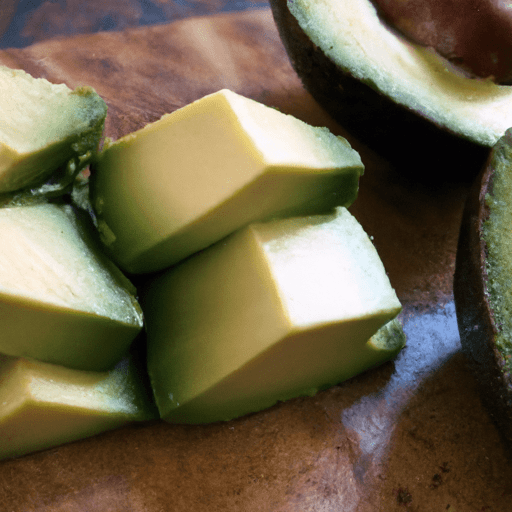Cooking with Avocado Cubes: Adding Creaminess and Nutritional Value to Your Dishes
Avocado cubes are a versatile and nutritious addition to any dish. Whether you’re a fan of avocados or not, these creamy green cubes can transform your meals and provide a subtle yet addictive taste. In this blog post, we’ll explore the taste, common uses in cooking, nutritional value, and share some interesting history and facts about avocado cubes.
Taste and Texture
Avocado cubes are known for their rich and buttery flavor. They have a smooth and creamy texture that melts in your mouth, making them perfect for adding a velvety touch to various dishes. The taste of avocado can be described as slightly nutty with hints of sweetness. When used in cooking, avocado cubes bring a unique and delightful creaminess that complements a wide range of ingredients.
Common Uses in Cooking
Avocado cubes are incredibly versatile, and their uses in cooking are only limited by your imagination. Here are a few popular ways to incorporate avocado cubes into your favorite recipes:
Salads and Bowls: Avocado cubes make a fantastic addition to salads and grain bowls. Toss them with mixed greens, cherry tomatoes, cucumbers, and a drizzle of lemon juice for a refreshing and healthy meal.
Guacamole: While traditional guacamole is made by mashing avocado, using avocado cubes adds an interesting texture and presentation to your guacamole. Simply combine the cubes with lime juice, diced onions, jalapenos, and cilantro for a chunky and flavorful dip.
Sandwiches and Wraps: Upgrade your sandwiches and wraps by adding avocado cubes. They bring a creamy element that perfectly balances the other ingredients, such as crispy lettuce, juicy tomatoes, and savory meats or plant-based proteins.
Smoothies: Avocado cubes are a secret ingredient for creating thick and creamy smoothies. Blend them with your favorite fruits, yogurt, and a splash of honey for a nutritious and indulgent treat.
Sushi Rolls: Avocado cubes are a common filling in sushi rolls, providing a creamy contrast to the fresh and vibrant flavors of fish, vegetables, and rice.
Nutritional Value
Avocado cubes are not only delicious but also packed with essential nutrients. Here’s a breakdown of their nutritional value per 100 grams:
- Calories: Avocado cubes contain approximately 160 calories, making them a satisfying addition to your meals.
- Healthy Fats: Avocados are a great source of monounsaturated fats, which are known to promote heart health and improve cholesterol levels.
- Fiber: Avocado cubes are high in dietary fiber, aiding in digestion and keeping you feeling full for longer.
- Vitamins and Minerals: Avocados are rich in vitamins C, E, K, and various B vitamins. They also provide potassium, magnesium, and folate.
- Antioxidants: Avocado cubes contain antioxidants that contribute to overall well-being and help fight inflammation.
History and Fun Facts
Avocado cubes have a long and interesting history. Native to Central and South America, avocados have been cultivated for thousands of years. The Aztecs considered avocados to be a luxurious fruit and even believed they possessed aphrodisiac properties. Today, avocados are widely enjoyed and have become a staple in many cuisines around the world.
Here are a few fun facts about avocados:
- Avocados are technically a fruit, not a vegetable.
- The word “avocado” comes from the Nahuatl word “ahuacatl,” which means testicle, referencing its shape.
- Avocados don’t ripen on the tree; they mature and soften after being picked.
- The Hass avocado, with its dark, pebbly skin, is one of the most popular and widely grown varieties.
Conclusion
Avocado cubes are a remarkable ingredient that adds depth, creaminess, and nutritional value to various dishes. Their rich taste, versatility, and health benefits make them a wonderful choice for incorporating into your culinary repertoire. Whether you’re preparing a salad, sandwich, or smoothie, avocado cubes are sure to elevate your meal and leave your taste buds wanting more. So, grab a ripe avocado, chop it into perfectly sized cubes, and embark on a culinary adventure with this delicious fruit. Enjoy the creamy goodness and explore the countless possibilities in your kitchen!
Avocado Cube
Origin: The avocado cube is not a naturally occurring form of avocado. It is a processed product made by cutting avocados into small, uniform cubes.
Common Uses: Avocado cubes are used in a variety of dishes such as salads, salsas, sandwiches, and sushi rolls. They can also be used as a topping for tacos, burgers, or toast.
Nutritional Benefits: Avocado cubes are rich in nutrients and healthy fats. They are a good source of dietary fiber, potassium, vitamin K, vitamin E, and vitamin C. Avocados also contain heart-healthy monounsaturated fats.
Unique Properties: Avocado cubes have a creamy texture and a mild, buttery flavor. They can add a distinct taste and richness to dishes.
Historical Significance: While the origin of avocado cubes as a specific product is unclear, avocados have a long history. They were cultivated in Central and South America for thousands of years and were an important part of the diet of the Aztecs and Mayans. Avocado consumption spread to Europe and other parts of the world during the Age of Exploration in the 16th century. Today, avocados are enjoyed globally and have gained popularity for their nutritional benefits and versatility in cooking.




Use the share button below if you liked it.
It makes me smile, when I see it.